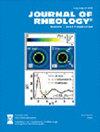多分散性和气泡聚类对牛顿介质中半稀气泡悬浮液稳定剪切粘度的影响
IF 3.2
2区 工程技术
Q2 MECHANICS
引用次数: 1
摘要
在这项工作中,我们研究了半稀多分散气泡悬浮液的稳定剪切流变学,以阐明多分散性对这些体系粘度的作用。我们从理论上证明,多分散性对悬浮液粘度的影响只有在气泡尺寸分布为双峰分布时才会变得明显,并且非常小和非常大的气泡具有相似的体积分数。在其他情况下,我们可以将多分散悬浮液视为单分散,平均气泡直径等于De Brouckere平均直径(公式:见文)。为了验证理论结果,我们进行了稳态剪切流变试验。我们的测量结果显示,在平均毛细管数在0.01和1之间时,悬浮液的相对粘度出现了意想不到的双幂律衰减。为了进一步研究这种行为,我们可视化了剪切作用下产生的气泡悬浮液。可视化实验显示,气泡在平均毛细数为0.01左右时开始形成团簇和线,此时我们观察到粘度的第一次衰减。聚类和排列与颗粒悬浮液中的剪切变薄行为有关。我们认为气泡悬浮液也是如此,气泡团和线与施加的剪切流对齐,减少流线扭曲,反过来,导致悬浮液粘度降低。因此,我们可以将相对粘度的第一次衰减归因于气泡团簇和螺纹的形成,证明我们观察到的新型剪切变薄行为是由于气泡团簇和变形的结合。本文章由计算机程序翻译,如有差异,请以英文原文为准。
Effect of polydispersity and bubble clustering on the steady shear viscosity of semidilute bubble suspensions in Newtonian media
In this work, we examine the steady shear rheology of semidilute polydisperse bubble suspensions to elucidate the role of polydispersity on the viscosity of these systems. We prove theoretically that the effect of polydispersity on suspension viscosity becomes apparent only if the bubble size distribution is bimodal, with very small and very large bubbles having similar volume fractions. In any other case, we can consider the polydisperse suspension as monodisperse, with the average bubble diameter equal to the De Brouckere mean diameter ([Formula: see text]). To confirm the theoretical results, we carried out steady shear rheological tests. Our measurements revealed an unexpected double power-law decay of the suspension relative viscosity at average capillary numbers between 0.01 and 1. To investigate this behavior further, we visualized the produced bubble suspensions under shear. The visualization experiments revealed that bubbles started forming clusters and threads at an average capillary number around 0.01, where we observed the first decay of viscosity. Clustering and alignment have been associated with shear-thinning behavior in particle suspensions. We believe that the same holds for bubble suspensions, where bubble clusters and threads align with the imposed shear flow, reducing the streamline distortions and, in turn, resulting in a decrease in the suspension viscosity. Consequently, we can attribute the first decay of the relative viscosity to the formation of bubble clusters and threads, proving that the novel shear-thinning behavior we observed is due to a combination of bubble clustering and deformation.
求助全文
通过发布文献求助,成功后即可免费获取论文全文。
去求助
来源期刊

Journal of Rheology
物理-力学
CiteScore
6.60
自引率
12.10%
发文量
100
审稿时长
1 months
期刊介绍:
The Journal of Rheology, formerly the Transactions of The Society of Rheology, is published six times per year by The Society of Rheology, a member society of the American Institute of Physics, through AIP Publishing. It provides in-depth interdisciplinary coverage of theoretical and experimental issues drawn from industry and academia. The Journal of Rheology is published for professionals and students in chemistry, physics, engineering, material science, and mathematics.
 求助内容:
求助内容: 应助结果提醒方式:
应助结果提醒方式:


